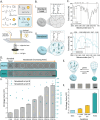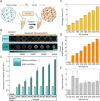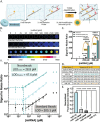Novabeads: Stimuli-Responsive Signal-Amplifying Hydrogel Microparticles for Enzymeless Fluorescence-Based Detection of microRNA Biomarkers
- PMID: 40557570
- PMCID: PMC12372440
- DOI: 10.1002/smll.202503990
Novabeads: Stimuli-Responsive Signal-Amplifying Hydrogel Microparticles for Enzymeless Fluorescence-Based Detection of microRNA Biomarkers
Abstract
Robust and ultrasensitive biosensing platforms for detecting clinically relevant biomarkers from liquid biopsies are vital for precision diagnostics. However, detecting low-abundance biomarkers such as microRNA typically necessitates complex and costly enzyme-based strategies like PCR or isothermal amplification. Here, a materials-driven approach is leveraged to rationally design stimuli-responsive, signal-amplifying, and graphically-encoded hydrogel microparticles, termed Novabeads, for enzyme-free and fluorescence-based biomarker detection. Novabeads incorporate pH-responsive acrylic acid moieties within a polyethylene glycol diacrylate-based network, enabling significant volume reduction (≈5 fold) upon pH modulation. This stimuli-responsive shrinking, coupled with high bioreceptor loading via thiol-ene click chemistry, enables rapid, enzyme-free optical signal amplification. As a proof-of-concept, fluorescently-labeled peptide nucleic acid (PNA) probes are designed for detecting the cancer biomarker miR-16, via a fluorogenic Förster resonance energy transfer (FRET)-based signal. Novabeads exhibit >30 fold signal enhancement over equivalent conventional hydrogel microparticles, driven by three synergistic mechanisms: increased probe loading (≈2.6 fold), enhanced target capture (≈2.8 fold), and shrinkage-driven amplification (≈5 fold), ultimately leading to over 7 fold reduction in detection limit (28.8 pM; 2.9 fmol), and an expanded linear dynamic range. This rationally designed materials-driven biosensing strategy enables next-generation robust, versatile and enzyme-free biosensors for liquid biopsy diagnostics.
Keywords: biosensing; microRNA; peptide nucleic acid; smart hydrogel; stimuli‐responsive.
© 2025 The Author(s). Small published by Wiley‐VCH GmbH.
Conflict of interest statement
The authors declare no conflict of interest.
Figures






Similar articles
-
Dual-catalytic hairpin amplification strategy as a highly efficient signal amplifier cooperative with COF@Au for ultrasensitive SERS detection of miRNA-21.Anal Chim Acta. 2025 Oct 1;1369:344361. doi: 10.1016/j.aca.2025.344361. Epub 2025 Jun 23. Anal Chim Acta. 2025. PMID: 40701727
-
In2O3 Nanoribbon-Based Field-Effect Transistor Biosensors for Ultrasensitive Detection of Exosomal Circulating microRNA with Peptide Nucleic Acid Probes.ACS Nano. 2025 Aug 19;19(32):29726-29736. doi: 10.1021/acsnano.5c10086. Epub 2025 Aug 6. ACS Nano. 2025. PMID: 40768607
-
Stimuli-responsive smart materials enabled high-performance biosensors for liquid biopsies.J Nanobiotechnology. 2025 Jul 1;23(1):477. doi: 10.1186/s12951-025-03541-5. J Nanobiotechnology. 2025. PMID: 40597218 Free PMC article. Review.
-
Can a Liquid Biopsy Detect Circulating Tumor DNA With Low-passage Whole-genome Sequencing in Patients With a Sarcoma? A Pilot Evaluation.Clin Orthop Relat Res. 2025 Jan 1;483(1):39-48. doi: 10.1097/CORR.0000000000003161. Epub 2024 Jun 21. Clin Orthop Relat Res. 2025. PMID: 38905450
-
Hydrogel-driven innovations for targeted delivery, immune modulation, and tissue repair in thyroid cancer therapy.Front Cell Dev Biol. 2025 Jul 25;13:1608709. doi: 10.3389/fcell.2025.1608709. eCollection 2025. Front Cell Dev Biol. 2025. PMID: 40791984 Free PMC article. Review.
References
MeSH terms
Substances
Grants and funding
LinkOut - more resources
Full Text Sources
Research Materials

